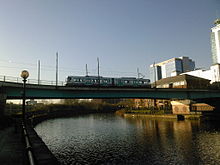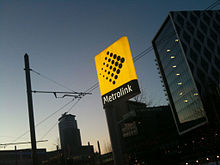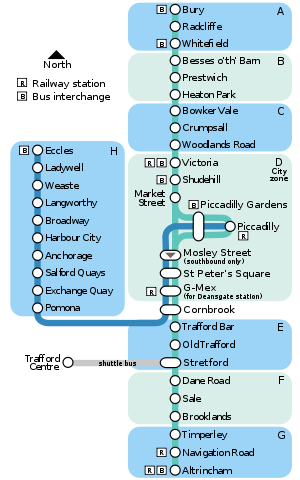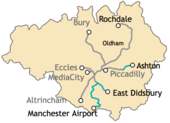- Manchester Metrolink
-
Metrolink 
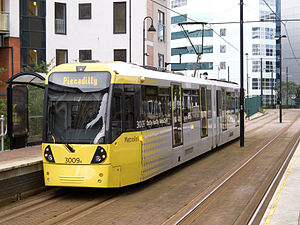
Info Owner Transport for Greater Manchester Locale Greater Manchester Transit type Tram/light rail[1] Number of lines 4 (7 by 2016, 8 planned)Number of stations 42 (as of July 2011, at least 96 by 2016) Daily ridership 56,000 Headquarters Metrolink House,
Queens Road,
Manchester, EnglandOperation Began operation 6 April 1992 Operator(s) RATP Group[3] Number of vehicles 26 T68
6 T68a
43 M5000 (74 by 2016)Train length 30 m (98 ft) Technical System length 37 km (23 mi) Track gauge Standard gauge Minimum radius of curvature 25 m (82 ft)[4] Average speed 48 km/h (30 mph) Top speed 80 km/h (50 mph) Metrolink route map Legend



Bury  (
( Bury)
Bury)



Radcliffe 



Whitefield 



Besses o'th' Barn 



Prestwich 



Heaton Park 



Bowker Vale 



Crumpsall 



Abraham Moss 



Woodlands Road 



(Weekday off peak) City Zone Victoria 


Shudehill 


Market Street 
Piccadilly Gardens 
Mosley Street 

Piccadilly 
St Peter's Square 



Deansgate-Castlefield (  Deansgate)
Deansgate)Cornbrook 







St Werburgh's Road 



Chorlton 




Firswood 



Trafford Bar Pomona 



Exchange Quay 



Old Trafford Salford Quays 



Stretford 
Anchorage 



Dane Road Harbour City 



Sale MediaCityUK 



Brooklands Broadway 



Timperley Langworthy 



Navigation Road 
Weaste 



Altrincham 

Ladywell 



(  Eccles)
Eccles)  Eccles
Eccles



This route map:
Metrolink[5] (also known as Manchester Metrolink)[6] is a light rail system in Greater Manchester, England. It consists of four lines which converge in Manchester city centre and terminate in Bury, Altrincham, Eccles and Chorlton-cum-Hardy. The system is owned by Transport for Greater Manchester (TfGM) and operated under contract by RATP Group.[3] Metrolink trams run on-street in Manchester city centre and Eccles, but most of the routes in the suburbs use former heavy rail lines and are therefore segregated from street traffic.
The tram system is currently undergoing major expansion with 4 new lines under construction by 2016, and further potential extensions to Stockport[7] and the Trafford Centre[2] envisaged, with a "second city crossing" line planned in central Manchester (the "City Zone") to ease congestion. In 2008 work on new Metrolink lines began, beginning the extension of the system to Chorlton, East Didsbury, Ashton-under-Lyne, Oldham, Rochdale, Sportcity, MediaCityUK and Manchester Airport. Services to MediaCityUK started in 2010, while services to Chorlton started in 2011.
Once completed, the extensions will increase the system's length from 37 to 97 kilometres (23 to 60 mi) with at least 99 stops and on completion, Greater Manchester will have the largest tram network in the United Kingdom[8] with a daily ridership of approximately 190,000.
Contents
History
Main article: History of Manchester MetrolinkThe need for a light rail system in Manchester was born out of a desire to link its two main railway stations, Piccadilly and Victoria. In the late 1960s and early 1970s there were plans for a "Picc-Vic tunnel" to carry main-line trains under the city centre,[9] but this proposal was abandoned because of excessive cost.
Plans for a light rail system in Manchester were first drawn up in 1984, consisting of three lines radiating from the city centre with an estimated cost of £42.5 million.[10] The plans were revised in 1987, and a trial using a prototype Docklands Light Railway train was carried out on a freight-only line.[11]
Authority to begin construction was granted in January 1988. This involved closing the heavy rail lines from Bury to Victoria (which was electrified using a non-standard and life-expired system) and from Altrincham to Manchester Picadilly for conversion, and a new route through the city centre streets. The line opened between Bury and Victoria in April 1992; the full system was operational from July that year.
A second phase, which extended the network to Eccles, was opened to Salford Quays (Broadway stop) in December 1999, and through to Eccles on 18 July 2000. The MediaCityUK spur, which is located on the Eccles line, opened in September 2010. The South Manchester line became the fourth new line to open on the Metrolink network, with trams running to Chorlton on 7 July 2011[12].
Operator
See also: History of Manchester MetrolinkMetrolink is run as a public-private partnership between Transport for Greater Manchester and private transport firms. Between 1992 and 2007 Metrolink was operated and maintained by Serco.[13] From 2007 to 2011 it was operated and maintained by Stagecoach Metrolink—part of the Stagecoach Group—under a 10-year fixed-term management contract, which was due to run until July 2017.[14][15] RATP Group bought Stagecoach's Metrolink businesses on 1 August 2011, but Stagecoach's other British light rail system, Sheffield Supertram was not sold.[3]
Routes, stations and depots
Routes
Monday to Saturday service:
- Bury – Altrincham - every 12 minutes (daytime only)
- Piccadilly – Bury - every 12 minutes
- Piccadilly – Altrincham - every 12 minutes
- Piccadilly – Eccles - every 12 minutes
- Piccadilly – MediaCityUK - every 12 minutes (daytime only - evening journeys provided by Eccles services)
- Victoria – St Werburgh's Road - every 12 minutes
The combined Monday-Saturday daytime frequency on the Bury and Altrincham routes is every 6 minutes.
Sunday and Bank Holiday service:
- Piccadilly – Bury - every 12 minutes 1000-1700, every 15 minutes at other times
- Piccadilly – Altrincham - every 12 minutes 1000-1700, every 15 minutes at other times
- Piccadilly – Eccles via MediaCityUK - every 12 minutes 1000-1700, every 15 minutes at other times
- Victoria – St Werburgh's Road - every 12 minutes 0930-1730, every 15 minutes at other times
The current route length is:
Phase 1 Bury – Victoria 15.9 km (9.9 mi) Victoria – Deansgate-Castlefield 1.9 km (1.2 mi) Spur to Piccadilly station 0.4 km (0.25 mi) Deansgate-Castlefield – Altrincham 12.2 km (7.6 mi) Phase 2 Cornbrook – Broadway 3.1 km (1.9 mi) Broadway – Eccles 3.9 km (2.4 mi) Phase 3 Trafford Bar – St Werburgh's Road 2.6 km (1.6 mi) Lines
This is a list of current service lines on the Metrolink:
Stations
Rail interchanges on Metrolink include Piccadilly, Victoria, Deansgate-Castlefield (formerly G-Mex, for Deansgate railway station), Altrincham and Navigation Road. Eccles is also available for interchange via a walk of 400 metres (440 yd).
Major bus interchanges are at Bury, Victoria, Shudehill, Piccadilly Gardens, Altrincham and Eccles. As of July 2011, there were 42 Metrolink stops: 19 of which are former British Rail stations on the Altrincham, Bury and South Manchester, 20 are new stops on the four lines plus the city centre, and 3 shared main line stations (Altrincham, Piccadilly and Victoria).
On 15 January 2010, a report was issued by GMITA (Greater Manchester Integrated Transport Authority) proposing the possible closure of Mosley Street station due to operational difficulties, including the annual maintenance cost of retractable steps on the trams to access the profiled platform, the cramped location being unsuitable for full length platform conversion and tram congestion affecting the nearby Piccadilly delta junction when frequency is increased[16]. Public notices were issued announcing Department for Transport consultations on the closure of Mosley Street and Woodlands Road stations ending February 2011, the closing date of the Woodlands Road consultation was later extended to March; Woodlands Road is to be replaced by a new station at Abraham Moss, some 250 metres to the north and already open, and by a new station at Queens Road which previously was only a staff halt. [17] Both consultations found in favour of closure but the final ministerial consent must await approval from the Office of Rail Regulation (ORR). In the meantime a parliamentary service has begun operating at Woodlands Road with the hours cut back so that trams only stop between 10am and 4pm on weekdays and pass through without stopping at other times.[18][19] As of June 2011 trams continue to stop at Mosley Street and work has not started at Queens Road.
Depots
The first Metrolink depot is south of Queen's Road (Cheetham Hill, M8) on the western side of the Bury line, between Victoria and Woodlands Road. The depot connections face Bury. Queens Road staff halt serves the depot.[20] This facility was not able to handle the expanded network, so GMPTE obtained a site for a second depot near Old Trafford.[21] Work on this site, alongside the track between Trafford Bar and Old Trafford, commenced in early 2009 with the demolition of the remaining buildings on the site, with the new depot opening in 2011 to coincide with the opening of the South Manchester Line. The final planned capacity for the Old Trafford depot is 96.
Fares and usage
Fares are charged according on the number of fare zones travelled through, and whether travel is in the peak period - before 0930 on weekdays (except public holidays).
Tickets are purchased from machines at each stop. Single journeys must be completed within 90 minutes, return journeys the same day. It is possible to purchase tickets from the machines for travel all day, for groups, or all weekend. Some ticket machines accept only coins, others also accept banknotes and give a maximum of £7 change.
Metrolink now uses ticketing stock which is similar to the systems in use with National Rail services. This includes the introduction of stronger credit card sized tickets with magnetic strip encoding. Previously smaller paper tickets were issued.
Metrolink carried 18.8 million passengers in 2004[22]. According to Metrolink sources, at least two million fewer car journeys have been made each year along the tram route due to the introduction of Metrolink[23]. However, other sources suggest that the longer diversion of trains between Northwich, Knutsford and Manchester via Stockport instead of via Sale, caused by the conversion of the Metrolink line, has resulted in more traffic on the A556 as people drive to Altrincham to catch the Metrolink instead of catching the train, resulting in large increases in traffic volumes on the A556.[24] A new £130m road is to be built to solve this problem.[25] Metrolink is the busiest tram system in the UK and many services are extremely busy, especially at peak times at the city centre stations. In the first two years of Metrolink operation, peak hour patronage was well below expected levels, but off-peak patronage exceeded expectations.[citation needed] Metrolink reacted by reducing peak fares which improved loadings.
Overall in its first full year of operation 11 million journeys were made on Metrolink compared to the annual expected level of 12 million journeys after maturity^ and in the first full year of operation on the Eccles line 3 million journeys were made on Metrolink compared to the annual expected level of 6 million journeys after maturity^. [26][27].
^Maturity is defined by the National Audit Office as 'promotors figures, usually up to five years after opening'[28].
Fare evasion and penalties
All Metrolink tickets must be purchased before travel. A "standard fare" of £100 is charged to passengers who evade fares by travelling without a valid ticket or pass. To avoid prosecution, this must be paid within 21 days, and is reduced by 50% if it is paid within 14 days.[29] Metrolink is policed by the Greater Manchester Police including Police Community Support Officers. An initiative by Greater Manchester Police, which saw around 15 officers routinely patrolling the tram network, was stopped due to lack of funds. On-board ticket checks are done by Metrolink Travel Safe Officers.
It should be noted that National Rail Enquiries sometimes give passengers invalid information about rail tickets being valid on Metrolink services. Passengers can only use rail tickets on Metrolink services in the following instances:
- The origin or destination on the ticket is a Metrolink stop or zone e.g. Sale Metrolink
- The ticket says Manchester CTLZ as the origin or destination, in which case it is valid within the city centre zone
- The ticket says Metrolink City as the origin or destination, in which case it is valid within the city centre zone (except in instance below)
- The ticket says Metrolink City as the origin or destination and route:Altrincham, in which case it is valid on the Altrincham to Deansgate-Castlefield line as well as within the city centre (these tickets are only available to and from Cuddington, Greenbank, Northwich, Lostock Gralam, Plumley, Knutsford, Mobberley, Ashley and Hale stations)
- The ticket states 'route:Metrolink'
- A TfGM ticket that combines rail and tram travel
- On Sundays only (and occasionally on other days during rail disruption) rail tickets between Manchester and stations between Mouldsworth and Navigation Road are accepted on Metrolink services between Altrincham and the city centre zone
Fleet
Class Image Top speed Number Built mph km/h T-68 
50 80 26 1991–1992 T-68a 
50 80 6 1999 M5000 
50 80 74 (on order) 2008–2011 T-68
The original vehicles operated on the Metrolink network since 1991 are T-68 trams built by the Italian manufacturer AnsaldoBreda. In 1999 the same company supplied six T-68a trams for operation on the Eccles extension. In December 2007 the Metrolink fleet consisted of 26 T-68 vehicles numbered in the 1000 series, and six T68a vehicles numbered in the 2000 series.
The trams normally operate singly, except during the rush hours when there are a few double trams along the Bury–Altrincham route. The trams consist of two units joined by an articulated section, with four doors per side. They are 30 m long and bi-directional with cabs at both ends.[30] The front and rear bogies are powered, with two 750 V, 105 kW motors per bogie. The third bogie, under the articulation, is not powered. The maximum speed is 80 km/h (50 mph), however 48 km/h (30 mph) is the maximum speed allowed for street running. There are 83 seats in each vehicle (plus four folding seats) and the nominal capacity is 200 passengers (250 maximum). Up to four trams can be worked in multiple, but the platform length on the Eccles line and city centre routes allow for a double unit only. Although the former heavy rail stations on the Bury and Altrincham lines can accept a triple or quadruple tram, each platform's public area is currently shorter than its full length.
M5000
Main article: M5000As part of the "Big Bang" network extension project, the Metrolink fleet is being expanded with the introduction of new Flexity Swift high-floor trams, built by Bombardier Transportation.
In April 2007 eight Flexity Swift LRVs were ordered, designated 'M5000', similar to the K5000 series used in the German cities of Cologne and Bonn, and similar to the low-floor models used by London's Tramlink. This initial order was quickly followed by additional orders for phase 3A and eventually a large order for phase 3B with a total of 62 trams on order. In October 2011 it was announced that an order further 12 'M5000' had been placed to enable some of the T68 vehicles to taken out of service, taking the current total order to 74. TfGM
As of the 1st of November 2011, 43 M5000 trams have been delivered[31]. Each tram is 28.4m long, and has 52 standard seats with a further 8 'perch' seats.
SPV (Special Purpose Vehicle)
Metrolink has one SPV and it is the original dating from 1991. Normally it can be seen shunting Queens Road Depot but can occasionally be seen in the Timperley Turnback siding on the Altrincham line. In 2009 it was repainted into an all yellow livery (the second livery for the car after its Metrolink White Livery) and numbered 1027 (the T68's fleet ending in 1026) and its sole wagon numbered 1028. The vehicle is passed for Eccles Running.
Boeing LRV
In 2001, with the upcoming Commonwealth Games to be held in Manchester, Metrolink decided that it would need an immediate enhancement in capacity and investigated purchasing a number of Boeing LRVs from Muni Metro in San Francisco.[32] Two vehicles were initially purchased for proving, with one sent to the Railway Inspectorate at Derby for safety testing, and the other direct to Metrolink for compatability tests,[33]But it derailed while on a test run to Eccles and was duped in Queens Road. with a further twelve stored pending sale. Eventually it transpired that the cost of making these vehicles suitable for use in the UK was too great for what was intended as a relatively short term measure, and the sale of the remaining vehicles was not taken forward. The vehicle at Metrolink's Queen's Road depot was eventually scrapped in 2007; the one at Derby remains.[34]
Future
Phase 3
Phase 3 is an ambitious expansion programme that will see trams running to Oldham, Rochdale, Ashton-under-Lyne, Wythenshawe and Manchester Airport.[35] It has been dubbed the "Big Bang" on account of the size of the planned extensions.[36]
Expansion of the Metrolink network has been promoted since the 1980s, but proposals have had mixed fortunes. In 2000, a £500 million expansion of Metrolink was announced by the Government, promising extensions to Oldham, Rochdale, Ashton-under-Lyne, Wythenshawe and Manchester Airport.[37] These plans were later cancelled due to increasing costs.[38]
Phase 3 was eventually split into two more phases due to funding constraints, known as Phase 3a and Phase 3b. In December 2004 the government announced that £520 million would be authorised for Phase 3a. Phase 3a was given the go-ahead by the Department for Transport in July 2006, with a £300m funding gap expected to be met by a loan.[39] Funding for Phase 3b was tied in with the Greater Manchester Transport Innovation Fund; following the rejection of congestion charging in Manchester in a 2008 referendum, councils grouped together and agreed a way to raise the capital through loans, council tax rises and the government releasing future funding.[40]
At a meeting of AGMA (the Association of Greater Manchester Authorities), 12 May 2009, cross-party agreement was reached between representatives of all ten Greater Manchester authorities for an increase in Council Tax to cover a number of transport improvements.[41] The list of 10 schemes costing £1.4 billion includes some road and bus improvements but crucially for Metrolink fills the gap in funding left by the shortfall of the "3a" scheme.
The money is to be found by a combination of an increase in council tax (by approx £2 per year per council tax payer), contributions from Manchester Airport, increased revenue from passenger journeys and the early release of some central government money, previously earmarked for transport improvements in the conurbation.[42] The revived project was presented by the leader of Manchester City Council Sir Richard Leese as "a new plan" which had been drawn up after the failure of the Transport Innovation Fund referendum.[43]
Summary of Metrolink Phase 3 extension plans East Manchester Line South Manchester Line Oldham & Rochdale Line Manchester Airport Line 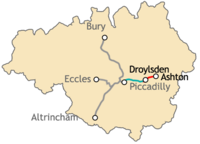
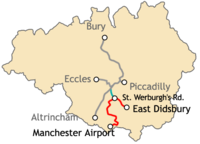
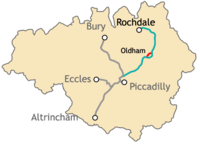

Phase 3a:
- Construction of the line as far as Droylsden
Phase 3b:
- Extension to Ashton-under-Lyne
Phase 3a:
- Construction of the line as far as St Werburgh's Road (opened July 2011)
Phase 3b:
- Extension to East Didsbury
Phase 3a:
- Conversion of part of the Oldham Loop line Victoria - Rochdale
Phase 3b:
- Re-route line through Oldham town centre
- Extension into Rochdale Town Centre
Phase 3a
- Construction of the line as far as St Werburgh's Road (complete)
Phase 3b:
- Creation of new line from St Werburgh's Road to Manchester Airport
East Manchester Line
(Summer 2012 — Summer 2013 )
South Manchester Line
(July 2011 — 2013)
Oldham & Rochdale Line
(July 2011 — 2014)
Manchester Airport Line
(July 2011 — 2016)
- Piccadilly

- New Islington (Summer 2012) [nb 1]
- Holt Town (Summer 2012)[nb 1]
- Etihad Campus (Summer 2012)[nb 1]
- Velopark (Summer 2012)
- Clayton Hall (Summer 2012)
- Edge Lane (Summer 2012)
- Cemetery Road (Summer 2012)
- Droylsden (Summer 2012)
- Audenshaw (Winter 2013)
- Ashton Moss (Winter 2013)
- Ashton West (Winter 2013)
- Ashton-under-Lyne

 (Winter 2013)
(Winter 2013)
- Victoria

- Shudehill

- Market Street
- Mosley Street (southbound only) (#)
- St Peter's Square
- Deansgate-Castlefield
 (Deansgate)
(Deansgate) - Cornbrook
- Trafford Bar
- Firswood
- Chorlton
- St Werburgh's Road
- Withington (Summer 2013)
- Burton Road (Summer 2013)
- West Didsbury (Summer 2013)
- Didsbury Village (Summer 2013)
- East Didsbury
 (Summer 2013)
(Summer 2013)
(#) - Station planned to close- Victoria

- Monsall (Nov/Dec 2011)
- Central Park (Nov/Dec 2011)
- Newton Heath and Moston (Feb/Mar 2012)
- Failsworth (Feb/Mar 2012)
- Hollinwood (Feb/Mar 2012)
- South Chadderton (Feb/Mar 2012)
- Freehold (Feb/Mar 2012)
- Westwood (Spring 2014)
- Oldham King Street (Spring 2014)
- Oldham Central (Spring 2014)
- Oldham Mumps
 (Feb/Mar 2012) (#)
(Feb/Mar 2012) (#) - Derker (Summer 2012)
- Shaw & Crompton (Summer 2012)
- Newhey (Summer 2012)
- Milnrow (Summer 2012)
- Kingsway Business Park (Summer 2012)
- Newbold (Summer 2012)
- Rochdale Railway Station
 (Summer 2012)
(Summer 2012) - Rochdale Town Centre
 (Spring 2014)
(Spring 2014)
(#) - temporary station to be built at former railway station until 2014, new street level station interchange opens in Spring 2014- Victoria

- Exchange Square (Mid 2016)
- St Peter's Square (#) (Mid 2016)
- Deansgate-Castlefield
 (Deansgate)
(Deansgate) - Cornbrook
- Trafford Bar
- Firswood
- Chorlton
- St Werburgh's Road
- Barlow Moor Road (Mid 2016)
- Hardy Farm (Mid 2016)
- Sale Water Park (Mid 2016)
- Northern Moor (Mid 2016)
- Wythenshawe Park (Mid 2016)
- Moor Road (Mid 2016)
- Baguley
 (Mid 2016)
(Mid 2016) - Roundthorn (Mid 2016)
- Haveley (Mid 2016)
- Benchill (Mid 2016)
- Crossacres (Mid 2016)
- Wythenshawe Town Centre
 (Mid 2016)
(Mid 2016) - Robinswood Road (Mid 2016)
- Peel Hall (Mid 2016)
- Shadowmoss (Mid 2016)
- Manchester Airport

 (Mid 2016)
(Mid 2016)
(#) - New extended station will be built at existing site with additional platforms
Phase 3a
Manchester Metrolink
Proposed Extensions (Phase 3a)Legend






Rochdale Railway Station 






Newbold 






Kingsway Business Park 






Milnrow 






Newhey 






Shaw and Crompton 






Derker 






Oldham Mumps 






Oldham Werneth 






Freehold 






South Chadderton 






Hollinwood 






To Bury; Failsworth 






Abraham Moss ; Dean Lane 






Woodlands Road; Central Park 






To Eccles 






Queens Road; Monsall 






Cornbrook 






Deansgate-Castlefield; Victoria 






St Peter's Square; Shudehill 






Mosley Street; Market Street 






Trafford Bar 






Piccadilly Gardens 






Firswood; Piccadilly 






To Altrincham; New Islington 






Chorlton; Holt Town 






St Werburgh's Road; Sportcity:Stadium 






Sportcity:Velodrome 






to Airport/East Didsbury; Clayton 






Edge Lane 






Cemetery Road 






Droylsden Phase 3a will take over the existing heavy rail Oldham Loop Line to Oldham and Rochdale, and extensions to Droylsden and to St Werburgh's Road in Chorlton-cum-Hardy.[35]
Environmental surveys began in April 2008[44] and continued until the autumn. Several companies were short-listed to build the extensions[44] with the M-Pact Thales consortium, made up of Thales, Laing O'Rourke and GrantRail, being eventually picked[45] in spring 2008. The project's final cost was calculated at £575 million and was signed off in May 2008.[45] Construction started in 2009[46] and the new lines becoming operational in 2011–12. The first new line to open was the South Manchester line to St Werburgh's Road, which opened on 7 July 2011[12]. Metrolink have announced trams will be running tests along the East Manchester Line from mid-July 2011, as far as Velopark. As of July 2011, all stations to this point are at a more advanced stage than those further along the route. There is speculation that Metrolink could run the line this far, with Velopark as a terminus, while the remainder of the line to Droylsden continues to be built.
Phase 3b
Phase 3b will divert the Phase 3a Rochdale line into Oldham and Rochdale town centres, and extend the Droylsden line to Ashton-under-Lyne and the St Werburgh's Road line to East Didsbury and Manchester Airport.[35]
Phase 3b forms part of Greater Manchester's integrated transport strategy, which recommends a wide-ranging package of transport investment and traffic management measures. In July 2007 GMPTE and the Association of Greater Manchester Local Authorities (AGMA) submitted a bid to the Government's Transport Innovation Fund to secure the funding for this package which would have guaranteed the extensions to these destinations. The bid was put to a referendum and rejected by the residents of Greater Manchester. Following on from this, AGMA agreed a package to raise the capital needed for the extensions and work began in late 2009.
Two further Metrolink extensions were included in the 2007 GMPTE plans, serving Stockport and the Trafford Centre. The Trafford line reappeared in 2010 plans now extended to new leisure and shipping developments at Port Salford. The Trafford line would continue from Pomona viaduct on the Eccles line, which has been built with the expansion in mind, and will have stops serving the Manchester United home ground at Old Trafford, the Imperial War Museum North, The Trafford Centre and Salford Reds.[47] These extensions are awaiting funding from private sector sources. Proposals to extend the East Didsbury line to Stockport town centre have not been approved by the Department for Transport and would therefore require ministerial approval.
Concerns were raised in the original Phase 3 proposals regarding the continued reliance on a single route through the city centre, which could have become a bottleneck when the new extensions opened, with six or seven routes running over the same track. GMPTE has reacted to this by including an additional line, probably along Cross Street between Deansgate-Castlefield and Victoria with stops at the Manchester Town Hall and Arndale Shopping Centre. There will be a Bus Rapid Transit route developed linking the Metrolink service in the centre of Manchester with Leigh and Salford that will not be reached by the Phase 3b extensions.
The full proposal for the Metrolink extensions, including the additional city centre crossing and Trafford Park lines, and linking with new Bus Rapid Transit routes, would take the total cost of Phase 3 to an estimated £1.2 billion, requiring revenue from the government and local council taxes.[48] AGMA commissioned a public referendum on the plans, including the congestion charge, and this concluded on 11 December 2008. Each borough representative agreed to vote in accordance with the public vote of their residents, with a minimum 7 to 3 majority of boroughs being required for the TIF proposal to proceed. 79% of the votes were cast against the plans.[49]
The network including all immediately planned proposed expansions would increase in size from 37 kilometres (23.0 mi) with 37 stops to 97.3 kilometres (60.5 mi) with at least 105 stops, and carrying 70 million passengers per year.[50][51]
Project Length New trams required Extension spur from Harbour City to Mediacity funded jointly by Peel Holdings and North West Development Agency, service to run between Cornbrook and Mediacity every 12 minutes 0.4 km (0.25 mi) 4 Additional route across Manchester city centre between Deansgate-Castlefield and Victoria 2 km (1.2 mi) Not yet known Conversion of existing railway from Victoria to Oldham and Rochdale (plus some street running) 25 km (16 mi) 14 Extension to Manchester Airport 14.5 km (9.0 mi) 12 Extension to Ashton-under-Lyne 10.2 km (6.3 mi) 10 Extension to East Didsbury 7.2 km (4.5 mi) 10 Further projects
The Metrolink expansion proposals still not programmed following this announcement are:
- The Trafford Park/Trafford Centre line (dependent on private sector funding)[52]
- The full extension of the Didsbury line into Stockport Town centre.
- The completion of the Manchester Airport loop (dependent on private sector funding)
In addition, feasibility work is continuing on possible further Metrolink expansions beyond the Phase 3 network:
- Conversion of the Marple rail service to tram-train or Metrolink operation (dependent on funding from rail operation budgets)[52]
- Conversion of the Manchester-Atherton-Wigan line to tram-train or Metrolink operation.[52]
- Conversion of the Manchester-Bolton line to tram-train operation.[52]
- Possible linkages between Metrolink and the East Lancashire Railway[53]
- Tram-train usage on the Mid-Cheshire line. There have been various proposals relating to this but most suggest the tram-train would be additional to the current heavy rail service. [54][55][56]
A 2001 official document called the Greater Manchester Strategic Rail Study by the Department for Transport,[57] also included several other potential routes that could be considered for potential Tram-Train or light rail working. This included an indicative route through inner South Manchester, which although drawn approximately on the reports map [58] as heading down Kingsway, a more likely, if technically difficult route, would be the Oxford Road-Wilmslow Road corridor. This route has also been raised as a potential Bus Rapid Transit route[59] where work is currently underway to restrict part of the route to buses only.[60] Princess Parkway was also considered at one point for the South Manchester (to Airport) route.[61]
Criticism
Metrolink has been criticised for its concessionary fares policy, in particular for the student fare which does not extend to students over 19 years old[62] (A National Railcard for 16-25s and full-time students over 25 is on sale for rail journeys [63] but is not valid on non National Rail journeys outside London such as airport express branded services, Eurostar and other light rail networks including Metrolink apart from through journeys from the National Rail network.) Metrolink is also unpopular with cyclists as bicycles are prohibited, unlike on heavy rail, and even folding bicycles must be fully covered. Metrolink provides secure storage for cycles at every stop and a review into risks, costs and attitudes to carrying cycles on trams found against any change in policy beyond rewording the description to allow soft cases for folding bicycles.[64]
GMPTE has invested a lot of money converting popular heavy rail lines to light rail, which has attracted criticism.[65][66] Critics have remarked that while trams may run more frequently than heavy rail services, they are much smaller, meaning that there is actually less capacity on the Altrincham and Bury lines than in the 1980s.[65] They also point out that all trams call at every station, meaning that they are slower at reaching Manchester than some of the 1980s train services.[65]
In their defence to the criticism GMPTE (now TfGM) claimed by 2006 the phase 1 lines were carrying 15 million passengers per year compared to 7 million per annum before conversion[67]. However, it should be noted that the 15 million quoted includes passengers travelling within the city centre, in particular providing a well utilised link between Manchester Piccadilly and Manchester Victoria stations, (one of the main reasons for the introduction of Metrolink) which is an additional service that Metrolink provides compared to the previous heavy rail service. It should also be noted that rail passenger figures for PTE areas are estimates and have there never been accurate figures since PTEs were formed due to the introduction of multi-modal tickets.[68]
The conversion of the Altrincham line has meant that trains from Knutsford, Northwich and Chester must take a longer route to Manchester through Stockport. In December 2008, some peak-time services had to be cut back further by terminating at Stockport, due to a shortage of paths through Stockport,[69] which resurfaced criticism about conversion of the Altrincham line.[66]
See also
- Transport in Manchester
- Manchester Corporation Tramways
- History of Manchester Metrolink
References
- ^ "LRTA World Systems List". Light Rail Transit Association. http://www.lrta.org/world/worldind.html. Retrieved 31 July 2011.
- ^ a b "Transport chiefs ‘lining up trams to Trafford Centre". menmedia.co.uk. 29 August 2010. http://menmedia.co.uk/manchestereveningnews/news/transport/s/1315389_transport_chiefs_lining_up_trams_to_trafford_centre. Retrieved 10 October 2010.
- ^ a b c "RATP buys Manchester Metrolink operator". Railway Gazette International. 2 August 2011. http://www.railwaygazette.com/nc/news/single-view/view/ratp-buys-manchester-metrolink-operator.html.
- ^ Tony Williams LRTA Manchester Area Officer (30 December 2009). "Manchester Metrolink Vehicles Facts & Figures". Lrta.org. http://www.lrta.org/Manchester/vehfact.html. Retrieved 17 November 2010.
- ^ http://www.metrolink.co.uk/
- ^ Department for Transport (2 February 2005). "Manchester Metrolink Working Group Minutes". dft.gov.uk. http://webarchive.nationalarchives.gov.uk/+/http://www.dft.gov.uk/foi/responses/2005/feb/manchestermetrolink/. Retrieved 31 July 2011.
- ^ "Wishlist brings new hope of Metrolink to Stockport". menmedia.co.uk. 6 October 2010. http://menmedia.co.uk/manchestereveningnews/news/s/1344846_wishlist_brings_new_hope_of_metrolink_to_stockport. Retrieved 10 October 2010.
- ^ "Future extensions". gmpte.com. http://www.metrolink.co.uk/futuremetrolink/future-extensions.asp. Retrieved 10 October 2010. "By the time we’ve finished the new extensions to MediaCityUK, Chorlton, Droylsden and Oldham and Rochdale we’ll have the largest tram network in the UK."
- ^ SELNEC (October 1971), SELNEC Picc-Vic Line, SELNEC publicity brochure
- ^ Light Rapid Transit in Greater Manchester, GMPTE, 1984 - publicity brochure
- ^ "Link". Neilsrailwayphotos.fotopic.net. http://neilsrailwayphotos.fotopic.net/c1513976.html. Retrieved 17 November 2010.
- ^ a b "Metrolink's new Chorlton line opens for business". Transport for Greater Manchester. http://www.tfgm.com/2009_news.cfm?news_id=9007167?submenuheader=3. Retrieved 6 July 2011.
- ^ http://menmedia.co.uk/manchestereveningnews/news/transport/public_transport/s/1454330_stagecoach-hand-over-control-of-metrolink-system-to-french-firm-ratp
- ^ May 2007/ "Stagecoach signs Manchester Metrolink contract" (Press release). Stagecoach Group. 29 May 2007. http://www.stagecoachgroup.com/scg/media/press/pr2007/29 May 2007/. Retrieved 28 December 2008.
- ^ "Stagecoach take over tram service". BBC News. 15 July 2007. http://news.bbc.co.uk/1/hi/england/manchester/6899507.stm. Retrieved 1 November 2008.
- ^ "http://www.gmita.gov.uk/download/2894/item_10_metrolink_mosley_street_stop". GMITA. 15 January 2010. http://www.gmita.gov.uk/download/2894/item_10_metrolink_mosley_street_stop. Retrieved 31 July 2011.
- ^ "Protesters fight to keep Woodlands Road Metrolink stop open". Manchester Evening News. 17 February 2011. http://menmedia.co.uk/manchestereveningnews/news/transport/public_transport/s/1408416_protesters_fight_to_keep_woodlands_road_metrolink_stop_open. Retrieved 15 June 2011.
- ^ "Campaigners accuse Metrolink of 'cynical action' after Woodlands Road stop is closed evenings and weekends". Manchester Evening News. 19 February 2011. http://menmedia.co.uk/manchestereveningnews/news/transport/public_transport/s/1418283_campaigners-accuse-metrolink-of-cynical-action-after-woodlands-road-stop-is-closed-evenings-and-weekends. Retrieved 15 June 2011.
- ^ "New Abraham Moss Metrolink stop to open". TfGM. 12 April 2011. http://www.tfgm.com/2009_news.cfm?news_id=9006588?submenuheader=3. Retrieved 15 June 2011.
- ^ "Bury line description". Light Rail Transit Association. http://www.lrta.org/Manchester/Bury_Line.html. Retrieved 20 December 2007.
- ^ "New Metrolink depot". Light Rail Transit Association. http://www.lrta.org/Manchester/advance_works.html. Retrieved 20 December 2007.
- ^ "Annual passenger journeys on light rail and tram systems: Great Britain, 1983/84 to 2009/10" (Excel spreadsheet). Department for Transport. 9 September 2010. http://www2.dft.gov.uk/pgr/statistics/datatablespublications/public/lightrail/usage/lrt0101.xls. Retrieved 31 July 2011.
- ^ "Tram Forward Topic Sheet No. 7". Light Rail Transport Association. http://www.lrta.info/tramforward/Topic7TFs.pdf. Retrieved 31 July 2011.
- ^ www.mcrua.org.uk/documents/draft_rus_response.pdf
- ^ http://menmedia.co.uk/manchestereveningnews/news/s/1346495_motorway_work_to_go_ahead_but_500m_road_schemes_stalled
- ^ http://assets.dft.gov.uk/publications/light-rail/green-light-for-light-rail.pdf
- ^ http://www.publications.parliament.uk/pa/cm201012/cmselect/cmtreasy/1146/1146vw05.htm
- ^ http://www.nao.org.uk/idoc.ashx?docId=58083d89-11a2-40f1-a948-9324b2234345&version=-1
- ^ "Conditions of carriage and passenger regulations applying to Greater Manchester Metrolink operated by Stagecoach Metrolink". Transport for Greater Manchester. Fares. http://www.metrolink.co.uk/moreinformation/conditions-of-carriage.asp. Retrieved 28 June 2011.
- ^ "Manchester Metrolink LRV". Ansaldobreda. Archived from the original on 30 May 2008. http://web.archive.org/web/20080530155345/http://www.ansaldobreda.com/files/prodotti/ManchesterMetrolink.pdf. Retrieved 4 January 2008.
- ^ "Manchester Metrolink Fleetlist". British Trams Online. http://www.britishtramsonline.co.uk/manchester.html. Retrieved 31 July 2011.
- ^ Lelchuk, Ilene (January 14, 2002). "Muni cars on a roll into city junkyard". San Francisco Chronicle. http://www.sfgate.com/cgi-bin/article.cgi?file=/chronicle/archive/2002/01/14/MN193692.DTL. Retrieved October 4, 2011.
- ^ "Metrolink's USA tram rolls in at the docks". Manchester Evening News. January 16, 2002. http://menmedia.co.uk/manchestereveningnews/news/s/40851_metrolinks_usa_tram_rolls_in_at_the_docks. Retrieved October 4, 2011.
- ^ Peter Erlich (4 October 2011). "Ex-Muni 1326 at Queen's Road Yard". Flickr. http://www.flickr.com/photos/milantram/4687547231/.
- ^ a b c "Metrolink Future Network". GMPTE. 2006. http://www.bbc.co.uk/manchester/travel/images/metrolink_map_2006.pdf. Retrieved 28 December 2008. - map of the proposed network expansion
- ^ "£289m for Metrolink 'Big Bang'". Manchester Evening News (Guardian Media Group). 22 March 2000. http://www.manchestereveningnews.co.uk/news/s/11/11937_289m_for_metrolink_big_bang.html. Retrieved 28 December 2008.
- ^ "£500m tram extension unveiled". BBC News. 22 March 2000. http://news.bbc.co.uk/1/hi/uk/687277.stm. Retrieved 28 December 2008.
- ^ "Government scraps trams extension". BBC News. 20 July 2004. http://news.bbc.co.uk/1/hi/england/manchester/3910235.stm. Retrieved 28 December 2008.
- ^ "Metrolink extension is announced". BBC News. 6 July 2006. http://news.bbc.co.uk/1/hi/england/manchester/5152948.stm. Retrieved 28 December 2008.
- ^ "Metrolink - the little Bang?". BBC. 7 July 2006. http://www.bbc.co.uk/manchester/content/articles/2006/06/23/230606_metrolink_decision_messageboard_feature.shtml. Retrieved 28 December 2008.
- ^ Ottewell, David (13 May 2009). "£1.4bn transport boost". Manchester Evening News (Guardian Media Group). http://www.manchestereveningnews.co.uk/news/s/1114922_14bn_transport_boost. Retrieved 17 May 2009.
- ^ "Transport Briefing". transportbriefing.co.uk. http://www.transportbriefing.co.uk/news/story?id=5876. Retrieved 24 May 2009.(subscription required)
- ^ Linton, Deborah (13 May 2009). "£1.4bn transport deal unveiled". Manchester Evening News (Guardian Media Group). http://www.manchestereveningnews.co.uk/news/s/1115242_14bn_transport_deal_unveiled. Retrieved 17 May 2009.
- ^ a b "Environmental experts inspect new Metrolink routes". GMPTE. 2 April 2008. http://www.gmpte.com/content.cfm?subcategory_id=103073&news_id=6011279. Retrieved 15 April 2008.
- ^ a b "£575 million Metrolink expansion gets final sign off". GMPTE. 16 May 2008. http://www.gmpte.com/content.cfm?subcategory_id=103073&news_id=6032063. Retrieved 20 May 2008.
- ^ "What Happens Next". GMPTE. http://www.gmpte.com/content.cfm?subcategory_id=6029065. Retrieved 20 May 2008.
- ^ "Metrolink future network" (PDF). GMPTE. http://www.gmpte.com/pdfmaps/metrolink/10-0698_Metrolink_geo_Dec_2010.pdf. Retrieved 19 March 2011.
- ^ Frame, Don; Craig, Ian (6 July 2006). "Metrolink wins a 'Little Bang'". Manchester Evening News (Guardian Media Group). http://www.manchestereveningnews.co.uk/news/s/217/217405_metrolink_wins_a_little_bang.html. Retrieved 10 July 2008.
- ^ "Voters reject congestion charge". BBC News. 12 December 2008. http://news.bbc.co.uk/1/hi/england/manchester/7778110.stm. Retrieved 12 December 2008.
- ^ "Government approves TIF package". Light Rail Transit Association. http://www.lrta.org/Manchester/mlnn2008.html#jne.c. Retrieved 17 March 2011.
- ^ "Manchester Metrolink Contract Awarded". Rail News. http://www.railnews.co.uk/news/metro/2008/06/17-manchester-metrolink-contract-awarded.html. Retrieved 17 March 2011.
- ^ a b c d "An Integrated Transport Strategy for Greater Manchester". GMITA. p. 13. http://www.gmita.gov.uk/download/12/greater_manchester_integrated_transport_strategy. Retrieved 13 July 2009.
- ^ Jenny Brookfield (15 August 2008). "Train or tram proposals for city link-up". Rossendale Free Press. http://www.rossendalefreepress.co.uk/news/s/1062737_train_or_tram_proposals_for_city_linkup. Retrieved 17 November 2010.
- ^ "Greater Manchester Local Transport Plan - Draft Long-Term Strategy" (PDF). http://www.gmpte.com/LTP3/documents/LTP3_Long_Term_Strategy_2010.pdf. Retrieved 17 November 2010.
- ^ Wilson, James (26 January 2011). "Transport plans could see the town on track for Metrolink". Knutsford Guardian (Newsquest Media Group). http://www.knutsfordguardian.co.uk/news/8811753.Transport_plans_could_see_the_town_on_track_for_Metrolink/.
- ^ "Manchester Metrolink tram services could run to Chester". BBC News. 19 January 2011. http://www.bbc.co.uk/news/uk-england-12223482. Retrieved 31 July 2011.
- ^ "Greater Manchester Strategic Rail Study" (PDF). June 2001. http://webarchive.nationalarchives.gov.uk/+/http://www.dft.gov.uk/pgr/rail/strategyfinance/strategy/termancesterstrategicrai3509.pdf/. Retrieved 31 July 2011.
- ^ "Greater Manchester Strategy Proposals". Flickr. http://farm3.static.flickr.com/2494/4197494570_9d10cfa091_b.jpg. Retrieved 31 July 2011.
- ^ "Greater Manchester’s Future Transport - How will the Transport Innovation Fund investment be realised?" (PDF). http://www.manchester.gov.uk/egov_downloads/Delivery_1_.pdf. Retrieved 17 November 2010.
- ^ Bainbridge, Pete (2 October 2009). "Buses to take over Oxford Road". Manchester Evening News (Guardian Media Group). http://www.manchestereveningnews.co.uk/community/public_transport/s/1153340_buses_to_take_over_oxford_road.
- ^ "Metrolink must go to South Manchester - Manchester City Council". Manchester.gov.uk. 21 June 2005. http://www.manchester.gov.uk/news/article/472/metrolink_must_go_to_south_manchester. Retrieved 17 November 2010.
- ^ "Concessions and Child Fares". Manchester Metrolink. http://www.metrolink.co.uk/tickets/concession.asp. Retrieved 28 June 2011.
- ^ "Make Epic Savings on rail fares". 16-25 Railcard. http://www.16-25railcard.co.uk. Retrieved 17 November 2010.
- ^ "Minutes of the meeting of the GMITA Bicycles on Trams Working Group held on the 5 November 2010" (PDF). GMITA. 5 November 2010. http://www.transportforgreatermanchestercommittee.gov.uk/download/3250/minutes-5_november_2010. Retrieved 31 July 2011.
- ^ a b c "Response to draft North-West Rail Utilisiation Strategy". Mid Cheshire Rail Users' Association. 2 February 2007. http://www.mcrua.org.uk/documents/draft_rus_response.pdf. Retrieved 29 June 2009.
- ^ a b "How bad is the Manchester Metrolink". Railwayscene.co.uk. http://www.railwayscene.co.uk/showthread.php?thread=4436. Retrieved 17 November 2010.
- ^ "a network for the twenty-first century". Metrolink. 2003. http://www.metrolink.co.uk/pdf/metrolink_brochure_p3.pdf. Retrieved 31 July 2011.
- ^ http://www.rail-reg.gov.uk/server/show/nav.1529
- ^ "Mid Cheshire Rail Report No. 76". Mid Cheshire Railway Users Association. Winter 2008-09. http://www.mcrua.org.uk/documents/mcrr76_1242278488.pdf. Retrieved 31 July 2011.
Further reading
- Holt, David (1992). Manchester Metrolink. UK light rail systems; no. 1. Sheffield: Platform 5. p. 96. ISBN 1-872524-36-2.
External links
Official sites
Maps
- Official Metrolink network map - current schematic map (issued July 2011)
- Phase 3 extensions schematic map 2011 - schematic map of phase 3 extensions plus additional proposed routes (Transport for Greater Manchester, July 2011)
- Phase 3 extensions geographic map - geographic map (Transport for Greater Manchester, July 2011)
- Google Map with Metrolink overlay - shows all lines and stations, both current and planned
- Manchester Metrolink Extension Project - geographic maps of Rochdale/Oldham, Ashton and Airport
- 2011 Metrolink Geographic maps of extensions to:
News
- "Future Metrolink". Transport for Greater Manchester. http://www.metrolink.co.uk/futuremetrolink/index.asp. Retrieved 31 July 2011. - news releases about Metrolink from Transport for Greater Manchester
- Light rail and tram news - TransportBriefing
Other sites
- "Transport - Metrolink". SkyscraperCity Forums. http://www.skyscrapercity.com/showthread.php?t=584932. Retrieved 31 July 2011.
- "Transport - Metrolink Extension". SkyscraperCity Forums. http://www.skyscrapercity.com/showthread.php?t=866944. Retrieved 31 July 2011.
- "Metrolink". TheTrams.co.uk. http://www.thetrams.co.uk/metrolink/. Retrieved 12 July 2008.
- "An Introduction to Metrolink". Light Rail Transit Association. http://www.lrta.org/Manchester/index.html. Retrieved 12 July 2008.
- "Metrolink Virtual". MSTS. http://www.metrolink-virtual.co.uk. Retrieved 12 July 2008.
- "Flash Movie of the new Alstom Metrolink Tram". Luminova. http://www.luminova.net/movies/gallery/player576.php?moviePath=ManchesterTram.flv. Retrieved 12 July 2008.
- Collection of Google Earth locations of Metrolink stations (Requires Google Earth software) from the Google Earth Community forum.
- "Manchester's Picc-Vic". Pipe Dreams. http://www.metromapsoftheworld.com/PipeDreams/PiccVic/. Retrieved 12 July 2008.
UK light rail systems Tramways CurrentBlackpool tramway · Manchester Metrolink · Midland Metro · Nottingham Express Transit · Sheffield Supertram · TramlinkFutureEdinburgh TramsProposedCancelledBristol Supertram · CITI Belfast · Cross River Tram · Leeds Supertram · Merseytram · Penistone Line Tram-Train · West London Tram
Metro CurrentProposedNorth and West London Light Railway · West London OrbitalPreserved Black Country Living Museum · East Anglia Transport Museum · Heaton Park Tramway · National Tramway Museum · Seaton Tramway · Wirral Transport Museum · Wirral TramwayMetrolink
Stations City zoneAltrincham LineAltrincham · Brooklands · Cornbrook · Dane Road · Navigation Road · Old Trafford · Sale · Stretford · Timperley · Trafford Bar
Bury LineAbraham Moss · Besses o'th' Barn · Bowker Vale · Bury · Crumpsall · Heaton Park · Prestwich · Radcliffe · Whitefield · Woodlands Road
Eccles LineAnchorage · Broadway · Eccles · Exchange Quay · Harbour City · Ladywell · Langworthy · MediaCityUK · Pomona · Salford Quays · Weaste
South Manchester LineChorlton · Firswood · St Werburgh's Road

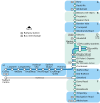
Operations OperatorsVehiclesHistory Former operatorsTransferred linesClosed stationsAbandoned plansUnder Construction Bury LineQueens Road
East Manchester LineAshton Moss · Ashton Under Lyne · Ashton West · Audenshaw · Cemetery Road · Clayton Hall · Droylsden · Eastlands City Stadium · Edge Lane · Holt Town · New Islington · Velopark
Oldham & Rochdale LineCentral Park · Derker · Failsworth · Freehold · Hollinwood · Kingsway · Monsall · Milnrow · Newbold · Newton Heath and Moston · Newhey · Oldham Central · Oldham King Street · Oldham Mumps · Rochdale railway station · Rochdale Town Centre · Shaw & Crompton · South Chadderton · Westwood
South Manchester LinesBaguley · Barlow Moor Rd. · Benchill · Burton Road · Crossacres · Didsbury · East Didsbury · Hardy Farm · Haveley · Hough End · Manchester Airport · Martinscroft · Moor Road · Northern Moor · Peel Hall · Robinswood Road · Roundthorn · Sale Water Park · Shadowmoss · West Didsbury · Withington · Woodhouse Park · Wythenshawe Town Centre · Wythenshawe Park
Proposed Bury LineBuckley Wells
Trafford Centre LineImperial War Museum · Lostock Parkway · Manchester United · Parkway Circle · Port Salford · Salford Reds · Trafford Centre · Trafford Quays · Village
Stockport LineGorsey Bank · Heaton Mersey · Kings Reach · Stockport Interchange
Second City CrossingExchange Square
Transport for Greater Manchester · UK light rail systems Transport in Greater Manchester Transport for Greater Manchester • Museum of Transport • Readycard Air Bus Arriva North West • Bluebird • Bullocks • Checkmate • Finglands • First Manchester • GM Buses • Jim Stones Coaches • JPT • Maytree Travel • Metroshuttle • Rossendale Transport • Speedwellbus • Stagecoach Manchester • South Lancs Travel • Stotts • Warrington Borough Transport • List of bus routes in Greater ManchesterRoad Tram Manchester Metrolink • Greater Manchester Metrolink LimitedRail TIF bid Congestion charging in Greater Manchester • Greater Manchester Transport Innovation Fund • United CitySee also: Transport in Manchester Categories:- Light rail in the United Kingdom
- Transport in Greater Manchester
- Transport in Manchester
- Tram transport in England
- Bury
- Electric railways in the United Kingdom
Wikimedia Foundation. 2010.

